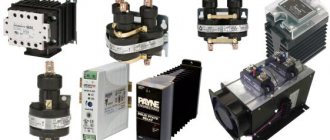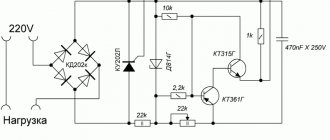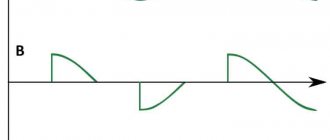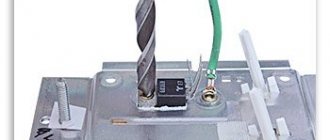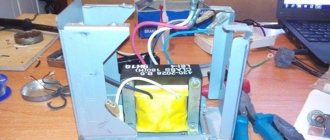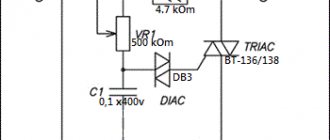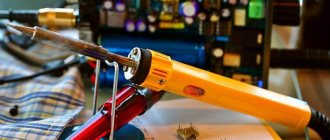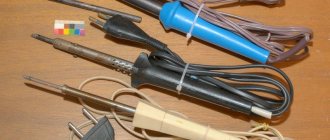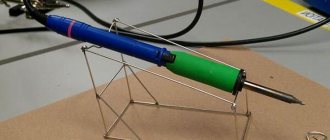In order to obtain high-quality and beautiful soldering, it is necessary to correctly select the power of the soldering iron and ensure a certain temperature of its tip, depending on the brand of solder used. I offer several circuits of homemade thyristor temperature controllers for soldering iron heating, which will successfully replace many industrial ones that are incomparable in price and complexity.
Attention, the following thyristor circuits of temperature controllers are not galvanically isolated from the electrical network and touching the current-carrying elements of the circuit can lead to electric shock!
To adjust the temperature of the soldering iron tip, soldering stations are used, in which the optimal temperature of the soldering iron tip is maintained in manual or automatic mode. The availability of a soldering station for a home craftsman is limited by its high price. For myself, I solved the issue of temperature regulation by developing and manufacturing a regulator with manual, stepless temperature control. The circuit can be modified to automatically maintain the temperature, but I don’t see the point in this, and practice has shown that manual adjustment is quite sufficient, since the voltage in the network is stable and the temperature in the room is also stable.
Classic thyristor regulator circuit
The classic thyristor circuit of the soldering iron power regulator did not meet one of my main requirements, the absence of radiating interference into the power supply network and the airwaves. But for a radio amateur, such interference makes it impossible to fully engage in what he loves. If the circuit is supplemented with a filter, the design will turn out to be bulky. But for many use cases, such a thyristor regulator circuit can be successfully used, for example, to adjust the brightness of incandescent lamps and heating devices with a power of 20-60 W. That's why I decided to present this diagram.
In order to understand how the circuit works, I will dwell in more detail on the principle of operation of the thyristor. A thyristor is a semiconductor device that is either open or closed. to open it, you need to apply a positive voltage of 2-5 V to the control electrode, depending on the type of thyristor, relative to the cathode (indicated by k in the diagram). After the thyristor has opened (the resistance between the anode and cathode becomes 0), it is not possible to close it through the control electrode. The thyristor will be open until the voltage between its anode and cathode (labeled a and k in the diagram) becomes close to zero. It's that simple.
The classical regulator circuit works as follows. AC mains voltage is supplied through the load (incandescent light bulb or soldering iron winding) to a rectifier bridge circuit made using diodes VD1-VD4. The diode bridge converts alternating voltage into direct voltage, varying according to a sinusoidal law (diagram 1). When the middle terminal of resistor R1 is in the extreme left position, its resistance is 0 and when the voltage in the network begins to increase, capacitor C1 begins to charge. When C1 is charged to a voltage of 2-5 V, current will flow through R2 to the control electrode VS1. The thyristor will open, short-circuit the diode bridge and the maximum current will flow through the load (top diagram).
When you turn the knob of the variable resistor R1, its resistance will increase, the charging current of capacitor C1 will decrease and it will take more time for the voltage on it to reach 2-5 V, so the thyristor will not open immediately, but after some time. The greater the value of R1, the longer the charging time of C1 will be, the thyristor will open later and the power received by the load will be proportionally less. Thus, by rotating the variable resistor knob, you control the heating temperature of the soldering iron or the brightness of the incandescent light bulb.
Above is a classic circuit of a thyristor regulator made on a KU202N thyristor. Since controlling this thyristor requires a larger current (according to the passport 100 mA, the real one is about 20 mA), the values of resistors R1 and R2 are reduced, R3 is eliminated, and the size of the electrolytic capacitor is increased. When repeating the circuit, it may be necessary to increase the value of capacitor C1 to 20 μF.
The simplest thyristor regulator circuit
Here is another very simple circuit of a thyristor power regulator, a simplified version of the classic regulator. The number of parts is kept to a minimum. Instead of four diodes VD1-VD4, one VD1 is used. Its operating principle is the same as the classical circuit. The circuits differ only in that the adjustment in this temperature controller circuit occurs only over the positive period of the network, and the negative period passes through VD1 without changes, so the power can only be adjusted in the range from 50 to 100%. To adjust the heating temperature of the soldering iron tip, no more is required. If diode VD1 is excluded, the power adjustment range will be from 0 to 50%.
If you add a dinistor, for example KN102A, to the open circuit from R1 and R2, then the electrolytic capacitor C1 can be replaced with an ordinary one with a capacity of 0.1 mF. Thyristors for the above circuits are suitable, KU103V, KU201K (L), KU202K (L, M, N), designed for a forward voltage of more than 300 V. Diodes are also almost any, designed for a reverse voltage of at least 300 V.
The above circuits of thyristor power regulators can be successfully used to regulate the brightness of lamps in which incandescent light bulbs are installed. It will not be possible to adjust the brightness of lamps that have energy-saving or LED bulbs installed, since such bulbs have electronic circuits built in, and the regulator will simply disrupt their normal operation. The light bulbs will shine at full power or flicker and this may even lead to their premature failure.
The circuits can be used for adjustment with a supply voltage of 36 V or 24 V AC. You only need to reduce the resistor values by an order of magnitude and use a thyristor that matches the load. So a soldering iron with a power of 40 W at a voltage of 36 V will consume a current of 1.1 A.
Operating principle of soldering station controller
There are many known circuits of homemade soldering iron heating regulators that are part of a station used at home. But they all work on the same principle, which is to control the amount of power delivered to the load.
Common options for homemade electronic regulators may differ in the following ways:
- type of electronic circuit;
- an element used to change the power supplied to the load;
- number of adjustment steps and other parameters.
Regardless of the design option, any homemade soldering station controller is a conventional electronic switch that limits or increases the useful power in the heating coil of the load.
As a result, the main element of the regulator, whether inside or outside the station, is a powerful power supply unit, which provides the ability to vary the temperature of the tip within strictly specified limits.
A sample of a classic soldering iron stand with an adjustable power supply module built into it is shown in the photo.
Modern triac regulator circuit
Below is a modern circuit diagram of a triac power regulator. In order to understand the principle of operation of a power regulator on a triac, you need to imagine how it works.
Triacs, unlike thyristors, can operate not only in DC circuits, but also in AC circuits. This is their main difference. The triac also operates in key mode - either open or closed. To open the transition A1-A2, you need to apply a voltage of 2-5 V to the control electrode G relative to pin A1. The triac will open and not close until the voltage between terminals A1-A2 becomes zero.
The triac power regulator circuit operates as follows. AC mains voltage is supplied through the load (incandescent light bulb or soldering iron winding) to terminal A1 of triac VS2 and one of the terminals R2. When the middle terminal of resistor R2 is in the extreme left position, its resistance is 0 and when the voltage in the network begins to increase, capacitor C1 quickly charges. When C1 is charged to a voltage of 30 V, a breakdown of the dinistor VS1 occurs and the current flows to the control electrode G VS2 and the junction of the triac A1-A2 opens (graph 1).
When you turn the knob of variable resistor R2, its resistance will increase, the charging current of capacitor C1 will decrease and it will take more time for the voltage on it to reach 30 V. Therefore, the triac will open after some time. The greater the value of R2, the longer the charging time of C1 will be and the triac will open with a longer delay. This way, less energy will be supplied to the load.
The given classic circuit of a triac power regulator can also operate at a network voltage of 127, 24 or 12 V. It is only enough to reduce the value of the variable resistor. In the above circuit, the power is regulated not from 0 volts, but from 30, which is more than enough for practical use. This circuit was successfully repeated when repairing the electronic circuit for controlling the rotation speed of a blender motor.
Thyristor circuit of the regulator does not emit interference
The main difference between the circuit of the presented soldering iron power regulator and those presented above is the complete absence of radio interference into the electrical network, since all transient processes occur at a time when the voltage in the supply network is zero.
When starting to develop a temperature controller for a soldering iron, I proceeded from the following considerations. The circuit must be simple, easily repeatable, components must be cheap and available, high reliability, minimal dimensions, efficiency close to 100%, no radiated interference, and the possibility of upgrading.
The temperature controller circuit works as follows. The AC voltage from the supply network is rectified by the diode bridge VD1-VD4. From a sinusoidal signal, a constant voltage is obtained, varying in amplitude as half a sinusoid with a frequency of 100 Hz (diagram 1). Next, the current passes through the limiting resistor R1 to the zener diode VD6, where the voltage is limited in amplitude to 9 V, and has a different shape (diagram 2). The resulting pulses charge the electrolytic capacitor C1 through diode VD5, creating a supply voltage of about 9 V for microcircuits DD1 and DD2. R2 performs a protective function, limiting the maximum possible voltage on VD5 and VD6 to 22 V, and ensures the formation of a clock pulse for the operation of the circuit. From R1, the generated signal is supplied to the 5th and 6th pins of the 2OR-NOT element of the logical digital microcircuit DD1.1, which inverts the incoming signal and converts it into short rectangular pulses (diagram 3). From pin 4 of DD1, pulses are sent to pin 8 of D trigger DD2.1, operating in RS trigger mode. DD2.1, like DD1.1, performs the function of inverting and signal generation (Diagram 4).
Please note that the signals in diagram 2 and 4 are almost the same, and it seemed that the signal from R1 could be applied directly to pin 5 of DD2.1. But studies have shown that the signal after R1 contains a lot of interference coming from the supply network, and without double shaping the circuit did not work stably. And installing additional LC filters when there are free logic elements is not advisable.
The DD2.2 trigger is used to assemble a control circuit for the soldering iron temperature controller and it works as follows. Pin 3 of DD2.2 receives rectangular pulses from pin 13 of DD2.1, which with a positive edge overwrite at pin 1 of DD2.2 the level that is currently present at the D input of the microcircuit (pin 5). At pin 2 there is a signal of the opposite level. Let's consider the operation of DD2.2 in detail. Let's say at pin 2, logical one. Through resistors R4, R5, capacitor C2 will be charged to the supply voltage. When the first pulse with a positive drop arrives, 0 will appear at pin 2 and capacitor C2 will quickly discharge through the diode VD7. The next positive drop at pin 3 will set a logical one at pin 2 and through resistors R4, R5, capacitor C2 will begin to charge.
The charging time is determined by the time constant R5 and C2. The greater the value of R5, the longer it will take for C2 to charge. Until C2 is charged to half the supply voltage, there will be a logical zero at pin 5 and positive pulse drops at input 3 will not change the logical level at pin 2. As soon as the capacitor is charged, the process will repeat.
Thus, only the number of pulses specified by resistor R5 from the supply network will pass to the outputs of DD2.2, and most importantly, changes in these pulses will occur during the voltage transition in the supply network through zero. Hence the absence of interference from the operation of the temperature controller.
From pin 1 of the DD2.2 microcircuit, pulses are supplied to the DD1.2 inverter, which serves to eliminate the influence of the thyristor VS1 on the operation of DD2.2. Resistor R6 limits the control current of thyristor VS1. When a positive potential is applied to the control electrode VS1, the thyristor opens and voltage is applied to the soldering iron. The regulator allows you to adjust the power of the soldering iron from 50 to 99%. Although resistor R5 is variable, adjustment due to the operation of DD2.2 heating the soldering iron is carried out in steps. When R5 is equal to zero, 50% of the power is supplied (diagram 5), when turning at a certain angle it is already 66% (diagram 6), then 75% (diagram 7). Thus, the closer to the design power of the soldering iron, the smoother the adjustment works, which makes it easy to adjust the temperature of the soldering iron tip. For example, a 40 W soldering iron can be configured to run from 20 to 40 W.
Temperature controller design and details
All parts of the thyristor temperature controller are placed on a printed circuit board made of fiberglass. Since the circuit does not have galvanic isolation from the electrical network, the board is placed in a small plastic case of a former adapter with an electrical plug. A plastic handle is attached to the axis of the variable resistor R5. Around the handle on the regulator body, for the convenience of regulating the degree of heating of the soldering iron, there is a scale with conventional numbers.
The cord coming from the soldering iron is soldered directly to the printed circuit board. You can make the connection of the soldering iron detachable, then it will be possible to connect other soldering irons to the temperature controller. Surprisingly, the current consumed by the temperature controller control circuit does not exceed 2 mA. This is less than what the LED in the lighting circuit of the light switches consumes. Therefore, no special measures are required to ensure the temperature conditions of the device.
Microcircuits DD1 and DD2 are any 176 or 561 series. The Soviet thyristor KU103V can be replaced, for example, with a modern thyristor MCR100-6 or MCR100-8, designed for a switching current of up to 0.8 A. In this case, it will be possible to control the heating of a soldering iron with a power of up to 150 W. Diodes VD1-VD4 are any, designed for a reverse voltage of at least 300 V and a current of at least 0.5 A. IN4007 (Uob = 1000 V, I = 1 A) is perfect. Any pulse diodes VD5 and VD7. Any low-power zener diode VD6 with a stabilization voltage of about 9 V. Capacitors of any type. Any resistors, R1 with a power of 0.5 W.
The power regulator does not need to be adjusted. If the parts are in good condition and there are no installation errors, it will work immediately.
The circuit was developed many years ago, when computers and especially laser printers did not exist in nature, and therefore I made a drawing of the printed circuit board using old-fashioned technology on chart paper with a grid pitch of 2.5 mm. Then the drawing was glued with Moment glue onto thick paper, and the paper itself was glued to foil fiberglass. Next, holes were drilled on a homemade drilling machine and the paths of future conductors and contact pads for soldering parts were drawn by hand.
The drawing of the thyristor temperature controller has been preserved. Here is his photo. Initially, the rectifier diode bridge VD1-VD4 was made on a KTs407 microassembly, but after the microassembly was torn twice, it was replaced with four KD209 diodes.
Soldering iron rewind
Winding a soldering iron tip
The tip is reinserted into the heater, clamped with screws and into the drill chuck. If you disassemble and unwind excess nichrome while holding the heating element in your hands, then everything will be much more complicated. The tie wire is removed.
The released fiberglass and mica wrappers are removed. In the mica on the side of the tip, there is a slot into which a conductor is inserted, going from the nichrome to the network wire - therefore, the weakened mica wrapper is removed from it rather than unwinding. Mica is a very fragile material. The end of the nichrome wire wound to the conductor is disconnected. Its thickness is just over 4 microns.
Nichrome must be wound onto something round; the ideal option is a spool of thread. He unscrewed it, rewinded it, and so on until the end. There is no need to disconnect the second end of the nichrome wire.
Soldering iron wire resistance
Now you need to wind a length of 400 Ohms, and in centimeters it will be approximately 70 (the total length of nichrome wire 300 cm is 1800 Ohms, hence 400 Ohms will be 66.66 cm). At a length of 70 cm, a latch (clothespin) is placed and in the hanging position of the coil, slightly guiding with your fingers, winding is carried out at intervals ensuring its termination at the first conductor. The number of attempts is not limited, the main thing is not to tear the nichrome. At the end of winding, a control resistance measurement is required.
As soon as we manage to wind the required amount of nichrome, we cut the wire with an allowance of 1 - 2 cm and wind it to the conductor. We put on the mica winding, passing the conductor into the slot in it and press it against it (naturally on top of it).
We install a fiberglass winding on top and, compacting it by pressing, wind the binding wire. A heating element designed for power supply voltage of 85 – 106 V is assembled.
How to reduce the level of interference from thyristor regulators
To reduce interference emitted by thyristor power regulators into the electrical network, ferrite filters are used, which are a ferrite ring with wound turns of wire. Such ferrite filters can be found in all switching power supplies for computers, televisions and other products. An effective, noise-suppressing ferrite filter can be retrofitted to any thyristor regulator. It is enough to pass the wire connecting to the electrical network through the ferrite ring.
The ferrite filter must be installed as close as possible to the source of interference, that is, to the installation site of the thyristor. The ferrite filter can be placed both inside the device body and on its outside. The more turns, the better the ferrite filter will suppress interference, but simply threading the power cable through the ring is sufficient.
The ferrite ring can be taken from the interface wires of computer equipment, monitors, printers, scanners. If you pay attention to the wire connecting the computer system unit to the monitor or printer, you will notice a cylindrical thickening of insulation on the wire. In this place there is a ferrite filter for high-frequency interference.
It is enough to cut the plastic insulation with a knife and remove the ferrite ring. Surely you or someone you know has an unnecessary interface cable from an inkjet printer or an old CRT monitor.
Disassembling the soldering iron
To disassemble the soldering iron, it was necessary to completely unscrew two screws connecting the protective casing to the heating element and holding the tip, and three self-tapping screws securing the working part to the handle. Remove the insulation from the wires and unscrew the connecting twists.
Mica with soldering iron spiral
There is a heating element inside the protective casing. That's what they have to do. It is necessary to change the amount of wound nichrome wire - change the resistance of the heating element. Now it is 1800 Ohms, 400 Ohms are needed. Why exactly so much? Currently working with a UPS, the soldering iron has a resistance of 347 Ohms, its power is from 19 to 28 W, there is a desire to make the second one less powerful, so I added Ohms.

